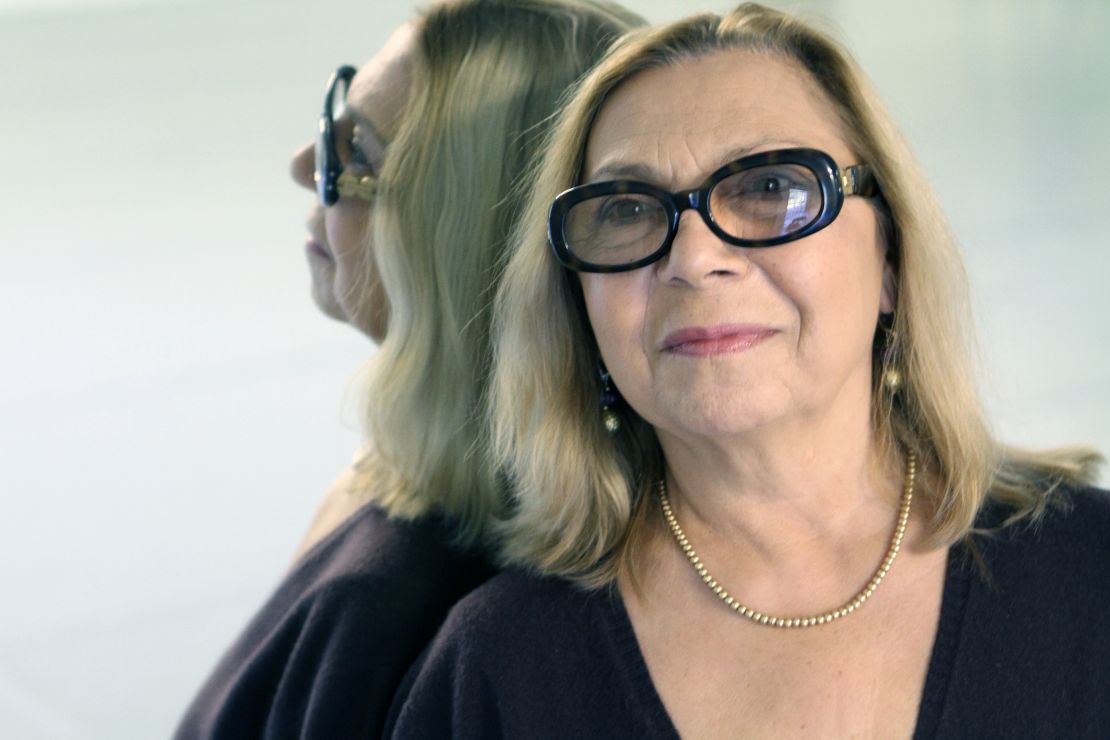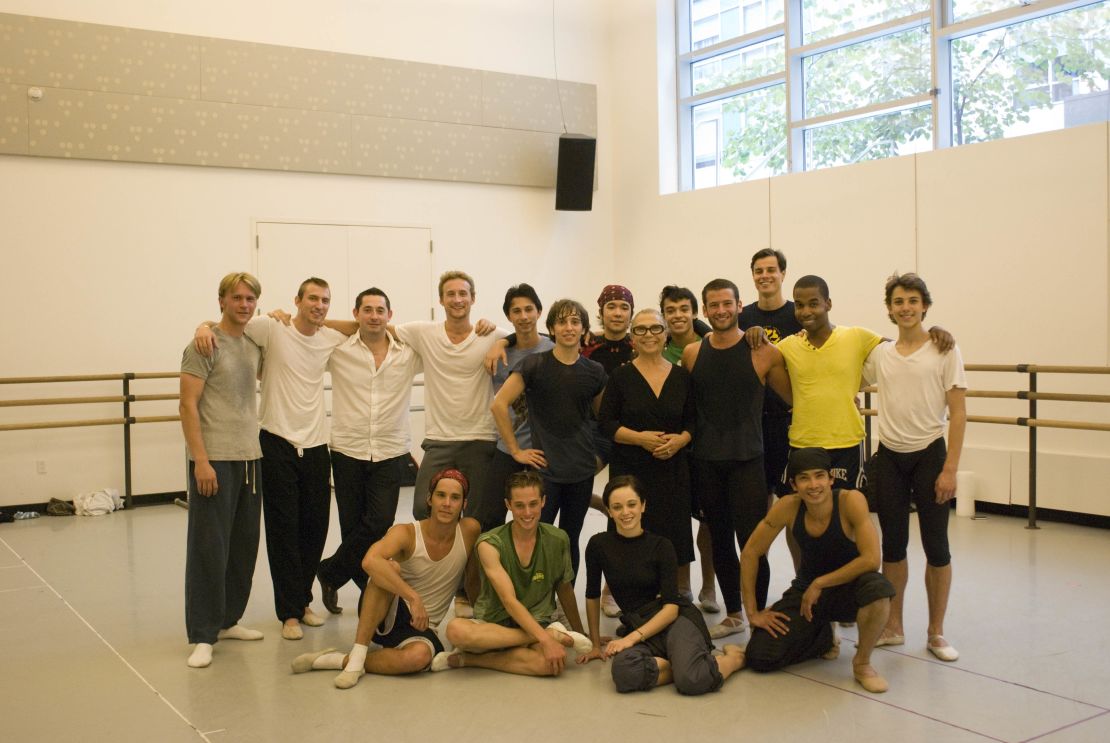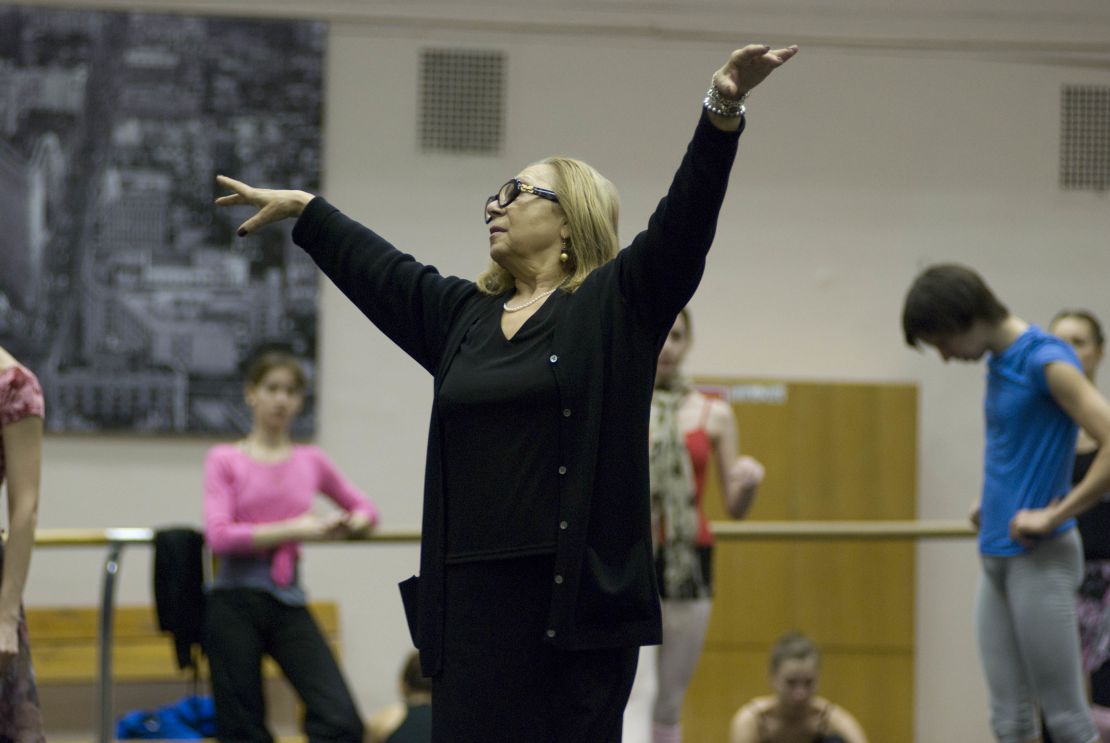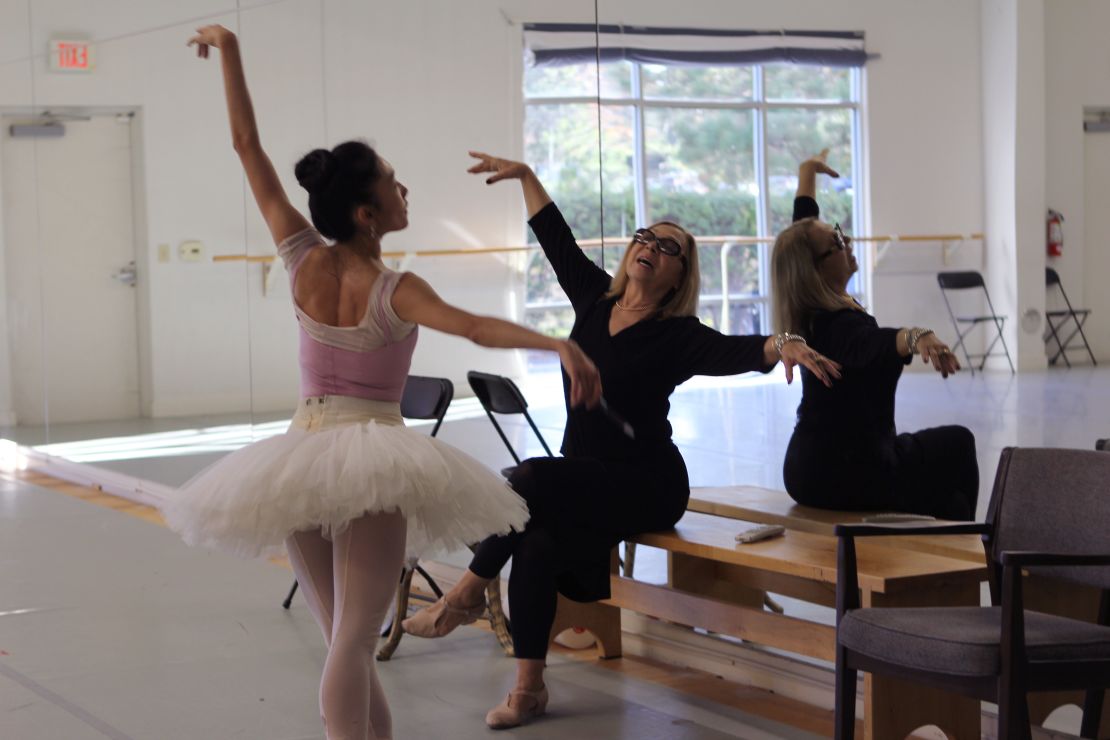Editor’s Note: CNN’s Emanuella Grinberg learned of Olga Kostritzky through her brother, who studied with Kostritzky at the School of American Ballet and is now a dancer with the Carolina Ballet.
Story highlights
Russian-trained ballet mistress Olga Kostritzky has shaped a generation of American dancers
She trained Natalie Portman for her role in "Black Swan" and appeared in the film
Now, she's helping prepare dancers in North Carolina Ballet for "The Nutcracker"
"The most important profession is to be a teacher," she says
As she sits at the front of the mirrored ballet studio and follows the dancer’s movements, Olga Kostritzky looks very much the part of the classic Russian ballet mistress.
Dressed in a black tunic and leggings, beige sandals and signature designer glasses, she sways in her seat and gestures as music from Tchaikovsky’s “Nutcracker Suite” fills the cavernous room.
A few feet away, dancer Malea Grubb twirls across the room on pointe, weary from a long day of rehearsals but determined to prove she’s worthy of the lead role in the dance of the ribbons.
The pressure is on: Carolina Ballet’s opening performance of “The Nutcracker” is three days away, and Grubb finally has the undivided attention of a guest coach she’s been wanting to work with for months.
Grubb took classes with Kostritzky this summer and was impressed by her attention to detail. Moreover, in a profession characterized by stress and constant physical exertion, Kostritzky’s calm, focused manner had put Grubb and her fellow dancers at ease.
With Nutcracker season under way across the country, fixer skills like Kostritzky’s are in high demand. Before arriving in Raleigh to work with Carolina Ballet on Nutcracker, she was in Siberia with another company. Ballet is her life, and even after more than 60 years of dancing and teaching, she shows no signs of slowing down. Don’t ask her how old she is because she won’t give you a number – “It doesn’t matter if you’re not 18,” she says – and not even her oldest daughter knows the year of Kostritzky’s birth.
Grubb begins a series of quick turns in place, only to lose her balance and fall back on her left foot. She steadies herself, looking for Kostritzky’s reaction.
The ballet mistress rises, chunky gold bracelets jingling as she approaches Grubb and puts her hands on her shoulders. A former dancer herself, Kostritzky understands the stress dancers face. She’s also aware of the intimidating effect she often has on them.
“Relax. You can do this. Don’t be nervous,” she whispers in her thick accent. “Just breathe through the movements.”
The words have their intended effect, and Grubb presses on.
“When she reassured me that my technical prowess would take care of itself and told me to focus instead on my breathing,” Grubb said, “that really helped me and got me excited about eventually doing it.”

Kostritzky’s reputation for bringing out the best in dancers has taken her around the world, shaping young students and coaching professionals with tough love and one-liners like “Why you give me Kmart when I ask for Cartier?”
She has taught throughout Russia, Europe, the United States and Latin America and worked with a diverse array of artists and entertainers, from ballet dancers Jock Soto and Damian Woetzel to British choreographer Christopher Wheeldon, film director Darren Aronofsky and actress Natalie Portman.
After meeting her at a lunch hosted by New York socialite Anne Bass, Vogue editor-at-large Andre Leon Talley once remarked that Kostritzky “is everything you would expect in a world-class ballet coach.”
She started out as a dancer at the Odessa State Ballet in her hometown but is proudest of her accomplishments as a teacher, coach and mentor.
“The most important profession is to be a teacher. Two sets of people are the most important: your parents and your teachers. College teachers, schoolteachers, ballet teacher.
“Because if you’re lucky and you have a good one,” she said, “they change your life.”
A taskmaster who ‘loved us’
Former students credit her with altering the course of their lives, regarding her as a “second mother.” At least 20 are in top-level professional dance companies nationwide, including New York City Ballet. She also helped Portman train for her role in the Academy Award-winning “Black Swan,” earning a shout-out from the actress in her Oscar speech. She also appeared in the documentary “Dancing Across Borders,” which tells the story of dancer Sokvannara Sar’s journey from Cambodia to the United States to train with Kostritzky.
“She demands only the best; complete commitment. Work, work, work and then savor the rewards but only for a moment because there is more work to be done,” said Peter Boal, director of Seattle’s Pacific Northwest Ballet. Boal studied with Kostritzky at a summer dance program when he was 14.
“She believes so completely in the art and impact of dance. You could feel her stage presence in everything she did. She was a taskmaster who scared us at first, but soon we figured out that she actually loved us.”
In an instance of art imitating life and vice versa, another former student tours with the national Broadway production of “Billy Elliot,” the movie-turned-musical about a young boy’s struggle to become a ballet dancer despite a lack of support from his family. The plot resonated with Max Baud, who plays adult Billy. As a teen, he struggled with torment from peers and credits Kostritzky with encouraging him to stick it out.
“She showed us this light at the end of the tunnel. She’d point to dancers like Jock Soto and Damian Woetzel as role models and tell us, ‘If you work your butt off, you’ll be able to dance and make a living doing the thing you love.’”
The foundation of a Kostritzky education, hard work and discipline, also translates to other professions and facets of life, he said.
“She made it clear in the beginning that this wasn’t just about ballet. Maybe you’re not going to be a ballet dancer. Maybe you’re going be a doctor or work for Wall Street. But the discipline you’re learning in this class, you could take this discipline and apply it in any other profession.”
Career advice? Call Olga
Kostritzky says she is grateful to her mother, a skilled seamstress who designed theater costumes, for indulging her wish to audition for the state ballet theater when she was 8. But it was her teacher who equipped her with the skills that students and dancers seem to value most in Kostritzky today.
“She knew how to push our buttons and knew how to make your mind work, your body work,” Kostritzky said. “She took me by the hand by the mirror, and I think it was maybe cruel, but it worked. She tells me, ‘Olga, you are not the most beautiful, but you are very smart and you’re going to make it.’
“And you know, she was right. This, I think, is the skill of the teacher. To find out what works for each one, make each one comfortable in their own skin.”

Kostritzky burnished her reputation for having a gift with children at the School of American Ballet, the in-house school for the New York City Ballet, where she taught more than 300 students in 18 years. The school is considered the premier training ground in the United States for children who aspire to dance professionally.
“Olga is a very natural and gifted teacher, hard-working and extremely devoted to her students,” the school’s artistic director and faculty chairman, Peter Martins, said in an e-mail.
She also taught girls’ classes, using humor and vivid metaphors to convey her point.
“She’d compare a step to a flower, or take off her necklace and say how all the beads have to be perfectly put together to form the whole (dance) variation,” said Lola Cooper, a Carolina Ballet dancer who studied with Kostritzky at the School of American Ballet.
Perhaps her greatest legacy is the role of mentor she continues to play in the lives of former students.
“She really loves and cares about her students,” said Seattle’s Boal. “She has lifelong friendships with most of her students, particularly the boys. Most would not have danced, taught, understood the meaning of commitment or found their potential without her. She actually changed lives. Whether these boys ended up dancing or not, Olga affected them in a positive way.”
She still gets calls from them all hours of the day seeking career advice, help figuring out a dance, even approval of their girlfriends.
One former student recalls how he turned down a job after such a phone call while he was on the rebound from losing his first professional gig.
School of American Ballet alum Nick Smirnov had just left his first job when he auditioned for a small dance company in Florida and was offered a job on the spot. His first thought? “Call Olga.”
“She said, ‘Absolutely not. You have to work for a bigger company,’” he said. “She told me to go to Raleigh and audition for Carolina Ballet. So I did, because you always do what Olga says.”
Six years later, Smirnov is a principal dancer with the company, doing classic Balanchine roles he’d dreamed of performing as a student. He has two major roles in this year’s “Nutcracker” production.
“We all owe so much to Olga,” he said. “She’s so positive that even when she gives you corrections in class or tells you what do as a dancer, she does it in a way that motivates you to be better. She makes you believe in yourself.”
Since leaving the School of American Ballet in 2009, Kostritzky divides her time between the United States and Russia, where she’s a guest teacher and coach for Siberia’s Novosibirsk State Opera and Ballet Theatre. She rarely spends time in her two-bedroom New York apartment four blocks from Lincoln Center. When she’s in New York, she never misses a chance to catch a ballet, opera or the symphony, though she was less than enthused over the Metropolitan Opera’s modernist approach to the latest production of “La Traviata.”

This month, she has taken up residence in an extended-stay hotel in Raleigh with her beloved Yorkie, Jerry Lewis, and a chihuahua named Dixie. She arrived after Thanksgiving to help train Carolina Ballet dancers for “The Nutcracker,” the biggest moneymaker of the year for ballet companies nationwide. The classic holiday tale of a young girl’s journey to a fantasy world of dancing mice and sugarplums is considered an opportunity to introduce ballet to audiences that don’t usually attend.
For Kostritzky, the Southern stop is also a reunion with friends, colleagues and students from different eras of her American life, which began in 1975 when she and her husband traded the sunny waterfront city of Odessa for Buffalo, New York.
Since moving to America, the self-described “tourist by birth” has lived in Houston, Oklahoma City, Philadelphia and New York. She had another daughter before divorcing her husband and remarrying.
She may sound Russian, but she considers herself American after spending so much time here.
“I love this country. It gave me an incredible life. I wish I could change my last name to Smith to make it easier for people,” she said, only half-joking.
‘We left everything’
The move from the Ukraine town on the Black Sea to America may have seemed like a risky move at the time for a pair of artists who didn’t speak English. They had a comfortable middle-class life in Odessa, a nice apartment and cars. Her husband, Ilia, played in the Odessa Philharmonic Orchestra, a job that allowed the couple to traverse the far reaches of the Soviet Union, bringing back exotic toys and fox fur coats for their daughter.
“The reality was life in Russia in the ’60s and ‘70s was so limited in terms of what you could read and the information available to you,” her daughter, Angela Kostritzky-Haws said in a telephone interview from her home in Westchester, New York.
“They knew that there was more out there. They wanted to be able to read what they wanted to read and not having that option, as artists, I think pushed them to leave.”

The exit from her homeland is a topic Kostritzky would rather not discuss except to acknowledge that her Jewish heritage on her mother’s side certainly made matters more difficult.
Leaving the Soviet Union in the Cold War era was notoriously difficult, especially for Jews, and often was perceived as an act of treason. Applying for an exit visa could mean severing ties with employers and family and paying multiple fees long before a visa was granted.
Many families like Kostritzky’s relocated to Italy after getting their exit visa while waiting for a U.S. visa to come through. Working through an agency, they were eventually placed in Buffalo, where they had a distant relative.
“When I look back, it’s like you can’t swim. But in the middle of the night you jump in the ocean just thinking, ‘Maybe I’m going to get to the coast and my life’s going to be better,’” Kostritzky said.
“I don’t know, maybe because we were young. When you’re young you think you will never die, everything’s going to work, so this is what we did. We left everything.”
A lack of English skills hindered their ability to find jobs, so Kostritzky said she and her husband took language classes at the University of Buffalo. But she immediately started seeking opportunities to teach ballet.
Her English teacher gave her the address of Buffalo’s Royal Academy of Ballet and Dance, where Kostritzky saw for the first time a ballet class accompanied by a tape recorder instead of musicians. In exchange for the opportunity to teach, the director offered her private language classes with a dance student.
Kostritzky also taught classes at the Buffalo Inner City Ballet, now known as the Buffalo City Ballet Company, where she witnessed another first: black dancers and dreadlocks. One summer in the late ’70s, she took five students to Saratoga to audition for the New York State Summer School of the Arts, a residential program that provides high school students with intensive training with acclaimed artists.
There, she met Robert Weiss, principal dancer with the New York City Ballet and director of NYSSSA’a ballet program. It was a connection that would prove lasting. Weiss recalled her students stood out because they understood him when he used the arcane language of ballet to ask them to perform dance combinations in the audition. And, he said, they performed well, easily earning spots in the program.

“She has a special gift. Many people teach ballet well; she’s one of the people who does it phenomenally,” said Weiss, now director of the Carolina Ballet. “She has a strong technical understanding of ballet and a wonderful artistic sense of the potential of various roles. In ballet, you have to have an eye. It’s about what you see. One person can look superficially and others, like her, can see more deeply.”
Weiss also recalls her persistence in wanting to teach at the summer program. When he turned her down because her background was in the “Russian way of dancing,” she showed up nearly every day to watch classes.
Taking another tack, she later proposed that Weiss hire her to teach character dance, a form of European folk dance common in classical ballet.
“Russians know it best, so hire me,” Weiss recalled her saying. “She was right, Russians were the best at character dance, so I incorporated character classes into the summer program and hired her.”
She taught for several summers and began to hone her reputation for administering a mix of tough love sprinkled with wry humor. The friendship with Weiss also proved enduring. Who else would travel three days from Siberia to help your ballet company, if not a friend?
Making kids listen
When Weiss became director of the Pennsylvania Ballet in the 1980s, he hired her as a teacher. She had stints with companies and schools in Oklahoma City and Houston before she started guest teaching at the School of American Ballet in 1989. Two years later, Peter Martins hired her as a full-time member of the faculty, where she worked alongside renowned New York City Ballet dancers Woetzel and Soto.
“She is a remarkably passionate and caring teacher,” said Woetzel, now director of the Aspen Institute Arts Program. “It is a moral question for her. The amount of effort and care one took with their training mattered as much or more than the ultimate output of success. Olga created wonderful people, as well as wonderful dancers.”
As that generation of dancers grows, some of her students have become teachers themselves. Igor Burlak met Kostritzky at the School of American Ballet when he was 10. Since then, he has performed with the New York City Ballet and been a principal dancer with the Minnesota Ballet. Through Kostritzky, he obtained a job at Novosibirsk in 2009, returning to the United States in September to join the faculty of the Boston Ballet.
When he began teaching children, he asked Kostritzky: How do you make kids listen?
“You have to be sweet but demanding,” she told him. “You have to make them fall in love.”




